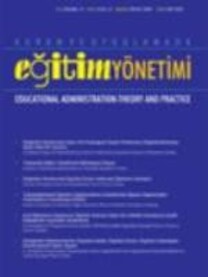Okullarda Psikolojik Güvencesizliğin Bireysel ve Kurumsal Değişkenler Açısından İncelenmesi
Analyzing the Psychological Unsafety in Schools in Terms of Individual and Institutional Variables
___
- Balcı, A. (2002). Örgütsel gelişme: Kuram ve uygulama (3. Baskı). Ankara: Pegem.
- Bateman, T. S., & Snell, S. A. (2016). Yönetim (Çev. S. Besler ve C. Erbil). Ankara: Nobel.
- Botero, I. C., & Dyne, L.V. (2009). Employee voice behaviour. Management Communication Quarterly, 23(1), 84-104, doi:10.1177/0893318909335415
- Carmeli, A., & Gittell, J. H. (2008). High-quality relationships, psychological safety, and learning from failures in work organizations. Journal of Organizational Behavior, 30, 709-729. https://doi.org/10.1002/job.v30:6
- Christensen, L. B., Johnson, R. B., & Turner, A. L. (2014). Research methods design and analysis. New York. Pearson.
- Çokluk, Ö., Şekercioğlu, G., & Büyüköztürk, Ş. (2010). Statistics for multiple variables: Practices in SPSS and LISREL. Ankara: Pegem Akademi.
- Edmondson, A. C. (1999). Psychological safety and learning behaviour in work teams. Administrative Science Quarterly, 44, 350-383. https://doi.org/10.2307/2666999
- Edmondson, A. C., Kramer, R. M., & Cook, K.S. (2004). Psychological safety, trust, and learning in organizations: A group-level lens. Trust and distrust in organizations: Dilemmas and approaches 12, 239-272.
- Edmondson, A.C., Higgins, M., Singer, S., & Weiner, J. (2016) Understanding Psychological Safety in Health Care and Education Organizations: A Comparative Perspective, Research in Human Development, 13(1), 65-83, doi: 10.1080/15427609.2016.1141280
- Eren, E. (2001). Örgütsel davranış ve yönetim psikolojisi (7. Baskı). İstanbul: Beta.
- Fraenkel, J. R., Wallen, N. E., & Hyun, H. H. (2012). How to design and evaluate research in education. New York: McGraw Hill.
- Fromm, E. (2014). Özgürlük korkusu (Çev. S. Koçak). İstanbul: Doruk. Garvin, D. A., Edmondson, A. C., & Gino, F. (2008). Is yours a learning organization? Harvard Business Review, 86(3), 109-116.
- Getzels, J.W. (1978). The communities of education. Teachers college records, 79, 659-682.
- Güney, S. (2000). Davranış bilimleri (2. Baskı). Ankara: Nobel.
- Hernandez, W., Luthanen, A., Ramsel, D., & Osatuke, K. (2015). The mediating relationship of self-awareness on supervisor burnout and workgroup civility and psychological safety: a multilevel path analysis. Burnout Research, 2, 36-49. doi: https://doi.org/10.1016/j.burn.2015.02.002
- Holley, L. C., & Steiner, S. (2005). Safe space: Student perspectives on classroom environment. Journal of Social Work Education, 41(1), 49-64. doi: https://doi.org/10.5175/JSWE.2005.200300343
- Kahn, W. A. (1990). Psychological conditions of personal engagement and disengagement at work. Academy of Management Journal, 33(4), 692-724. doi: https://doi.org/10.2307/256287
- Kahn, W. A. (2007). Meaningful connections: Positive relationships and attachments at work. In J. E. Dutton, & B. R. Ragins (Eds.), Exploring positive relationships at work: Building a theoretical and research foundation (pp. 189-206).
- Karataş, E. (2009). Job values and organizational culture in educational administration (Master thesis). Uşak University, Uşak, Turkey. Kramer. R. M. (1999). Trust and distrust in organizations: Emerging perspectives, enduring questions. Annual Review of Psychology, 50, 569- 598. doi: https://doi.org/10.1146/annurev.psych.50.1.569
- Lyu, X. (2016). Effect of organizational justice on work engagement with psychological safety as a mediator: evidence from china. Social Behaviour and Personality, 44(8), 1359-1370. doi: https://doi.org/10.2224/ sbp.2016.44.8.1359
- Miles, J. A. (2012). Management and Organization Theories. San Francisco: Wiley.
- MEB (2017). Milli Eğitim Bakanlığı Stratejik Planı 2015-2019. Retrieved from http://sgb.meb.gov.tr/www/mill-egitim-bakanligi-2015-2019-stratejik-planiyayinlanmistir/icerik/181
- Özdemir, S. (2016). Türk eğitim sistemi ve okul yönetimi (4. Baskı). Ankara: Pegem Akademi.
- Sağnak, M. (2017). Ethical leadership and teachers’ voice behaviour: The mediating roles of ethical culture and psychological safety. Educational Sciences: Theory and Practice, 17(4), 1101-1117. doi: 10.12738/estp.2017.40113.
- Schein, E. H. (2010). Organizational culture and leadership. San Francisco: Jossey-Bass.
- Schermerhorn, J. R., Hunt, J. G., Osborn, R. N., & Uhl-Bien, M. (2010). Organizational Behaviour. San Francisko: Wiley.
- Schlechty, P. C. (2005). Shaking up the school house (Çev. Y. Özden). Ankara: Nobel.
- Seçer, İ. (2015). The process of development and adaptation measurement: applications of SPSS and LISREL. Ankara: Anı
- Tabachnick, B. G., & Fidell, L. S. (2013). Using multivariate statistics (8th ed.). New York: Pearson.
- Töremen, F. (2002). Eğitim örgütlerinde değişimin engel ve nedenleri. Fırat Üniversitesi Sosyal Bilimler Dergisi, 12(1), 185-202.
- Uğurlu, C. T., & Abdürrezzak, S. (2016). Research of teachers’ views on effective school and school leadership. Kuram ve Uygulamada Eğitim Yönetimi, 22(3), 401-428. doi: https://doi.org/10.14527/ kuey.2016.016
- Wanless, S.B. (2016). The role of psychological safety in human development. Research in Human Development, 13, 6-14. doi:10.1080/15427609. 2016.1141283
- Yıldırım, K., & Yenipinar, Ş. (2017). Psychological unsafety in schools: The development and validation of a scale. Journal of Education and Training Studies, 5(6), 167-176. doi: 10.11114/jets.v5i6.2372
- ISSN: 1300-4832
- Yayın Aralığı: 4
- Başlangıç: 1995
- Yayıncı: Pegem Akademi Yayıncılık Eğitim Danışmanlık Hizmetleri Tic. Ltd. Şti.
Okullarda Psikolojik Güvencesizliğin Bireysel ve Kurumsal Değişkenler Açısından İncelenmesi
ŞENYURT YENİPINAR, KAMİL YILDIRIM
Ortaöğretim Kurumlarında Örgüt Kültürü ile Yabancılaşma Arasındaki İlişkinin İncelenmesi
MEHMET KORKMAZ, Mehmet Sabir ÇEVİK
Örgütsel Mutluluk Ölçeğinin Türkçeye Uyarlanması
Üniversite Öğrencilerinin Sosyal Medya Kullanım Amaçlarının İncelenmesi
